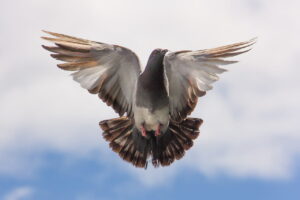by The Cowl Editor on September 16, 2021
Creative Non-Fiction
by Sarah McLaughlin ’23

There are countless bird-related trivia facts I like to spout over the dinner table, during walks to class, or in the delirium of three a.m. roommate conversations, but my favorite might be the fact that there is no scientific difference between pigeons and doves.
Did you know that the sooty-looking birds pecking at moldy hot dog buns between parked cars on the streets of New York are also known as city doves? Or that the one sent by Noah from his arc that returned with an olive branch (or sent by Utnapishtim in The Epic of Gilgamesh; yes, I paid attention in Civ) could also be called a white pigeon?
The reason I clarify that there is no scientific difference is because there is, of course, a difference in our minds. Sure, in the olden days one’s mind might conjure the image of a carrier pigeon, but in the twenty-first century we have much more efficient messaging technology, so the word “pigeon” in our brains remains generally confined to the realm of smoggy, overcrowded urban areas, perhaps with half-empty Dunkin’ bags littering the sidewalks. Doves remind us of quite the opposite scene—rainbows and receding flood waters, the hand of Aphrodite, an open window at a wedding or the Vatican, maybe a gentle, kind person. But in reality, doves are white pigeons, and pigeons are gray doves.
I write about this fact not to educate the public on avian taxonomy, or to explore the etymologies of these two words, or to make some grand allegorical statement about setting aside our differences and accepting every individual as an equal member of the human race—although these are all great things. Rather, I write simply to ponder the fact that culture is a strange thing, because most of us do not think about doves or pigeons on a daily basis and yet we immediately have all these preconceived ideas. However, if I were to ask one of my classmates to mentally divide ninety-six by twelve, an action consciously practiced, it would take longer for their mind to arrive at the answer than it would take for New York City hot dog bun-eating street pest to come when beckoned with the word pigeon.
I could argue that everything would be different if we only went back in time a few thousand years and asked Utnapishtim to send off a gray dove, but even if the legend is true, that’s not what I’m here for. To be honest, I’m not quite sure what my reason is. I guess I just felt like writing about pigeons and giving them a bit of the positive press they deserve. They were pretty useful before email, after all. But now, I just think they’re pretty, period. And you can feel free to disagree; maybe it’s the orange eyes or strangely fluorescent scaly feet that rub you the wrong way. Take a look at their feathers under direct sunlight, though, and watch how iridescent they are, shifting between hues of jade and amethyst.
Another fun fact—many birds have plumage that reflects ultraviolet light, and because their eyes are so sensitive to it, they use it to recognize one another. So, maybe, pigeons are even more beautiful to other pigeons than they can be to us. Each individual bird’s UV markings are unique, like fingerprints, so even if we see a flock of pigeons as a monotone mass, they are far from identical.
You might be wondering what inspired me to go off on this peculiar tirade. The reason is because there’s been a pigeon wandering around Slavin lawn for the past couple of days. Ever since I moved in, I’ve seen him strutting around each time I pass, bobbing his little head and probably looking for abandoned Dunkin’ bags. I wonder if he has a flock or has claimed the whole campus to himself. Either way, he doesn’t seem too upset to see us all back here. He stayed right beside me on the path for a few moments the other day and I slowed down my stride just so he could keep pace. People probably looked at me like I was nuts, but it was an unexpected peaceful moment in an otherwise rushed and stressful day. So if you happen to see the Slavin pigeon—Slavin dove, if you prefer—maybe you’ll stop for a few seconds to think about taxonomy or language or culture. Maybe tell him I said hi.
Comments are closed.
Wow, you are such a great writer and story teller! 💕